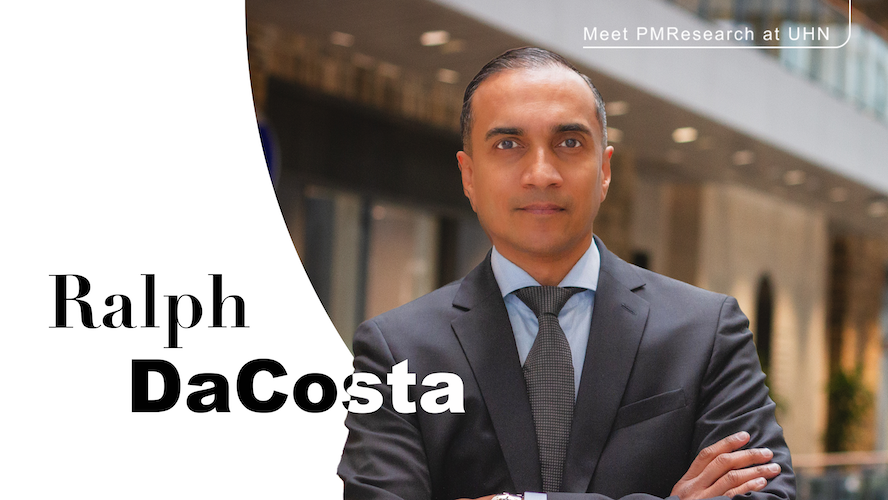
In the operating room, a removed tumour can look deceptively uniform — like any other piece of tissue. But within it lies a bustling city of cancer cells, blood vessels, and connective tissue, invisible to the naked eye. Dr. Ralph DaCosta’s research team at UHN’s Princess Margaret Cancer Centre turns this hidden world into vivid colour, revealing cancer’s behaviour in real time.
His team discovered a dynamic, constantly changing tumour microenvironment surrounding pancreatic cancer cells (published in Science Advances), that could help oncologists tailor treatment schedules for patients who have one of Canada’s deadliest cancers.
"We saw pockets of pancreatic cancer cells that are inherently hypoxic — in other words, they have low oxygen levels. They are enveloped by very dense layers of connective tissue called collagen fibers, preventing blood vessels from getting inside,” Ralph describes.
To detect pockets of oxygen-starved (hypoxic) cancer cells, the team, led by former doctoral student Dr. Timothy Samuel, used a sophisticated combination of fluorescent labelling and advanced optical microscopy in living models of cancer to light up different components in the tumour microenvironment.
Cancer cells in preclinical models were engineered to glow red (DsRed) at all times, while a built-in hypoxia sensor made them glow green (GFP) only under low-oxygen conditions. Blood vessels were highlighted in cyan using a fluorescent antibody, allowing the team to measure oxygen access relative to blood supply. Meanwhile, collagen fibers—key components of the tumour’s stiff, fibrotic structure—were visualized using second harmonic generation microscopy, a special form of laser light that makes collagen fibers shine like white snow under a spotlight.
These rigid, oxygen-starved pockets of cancer emerge, persist, and can contribute to tumour progression: they may fuel a vicious cycle of tumour growth and spread by cutting off oxygen, reshaping collagen and the microenvironment over time, and helping cancer cells evade treatment.
In a follow-up study published in Scientific Reports, the team used this imaging platform to track how patient pancreatic tumour cells responded to radiation. After radiation treatment, fewer cells continued to glow red, indicating reduced viability of cancer cells, and there was a reduction in green fluorescence, signalling less hypoxia. The presence of DNA damage markers and slowed cell growth confirmed that the treatment was effective. Through quantitative analysis, the study also offered insights into optimizing treatment timing and dosing to improve treatment outcomes.
This imaging system gained widespread recognition that led to a collaboration with Drs. Mark Minden, John Dick, Stephanie Xie, and Tak Mak (and collaborators abroad), to illuminate how blood cancers interact with the immune system and respond to immunotherapy. This time, the team needed ways to visualize whether cancer cells were alive or dead to better track treatment response, as the bone marrow microenvironment is remodelled during disease progression. They developed a new marker for tumour cell death — a pink fluorescent signal that is emitted when the treatment kills a leukemia cell.
“We have also found ways to visualize different immune cell populations in the bone marrow where leukemia cells develop,” Ralph adds. “It will let us see an entirely different cellular landscape with complex microarchitecture, and the interaction between leukemia cells and immune cells. I’m very excited by this new frontier where imaging can play a key role in improving our understanding of tumour biology. This type of work has never been done before.”
Applying Optical Physics to Medicine
Ralph’s obsession with the optical world started when he was a child, building a ruby crystal laser in his garage. The resulting laser beam was invisible — until he sprinkled talcum powder in the air and saw it glow red. For the first time, he felt the magic of visualizing the unseeable. That moment inspired him to learn more about light through physics and math.
From a summer job in Dr. Brian Wilson’s Lab at the Princess Margaret Cancer Centre, he redirected his path to cancer research.
“I came upon a newspaper article that stated how a star scientist, Dr. Brian Wilson, was coming from Hamilton to Toronto to start a whole new field of bio-photonics.” Ralph cold-called Brian to express his interest in studying light for medical applications, which led to his first job and eventually a PhD. In 2014, Ralph started his own independent research lab and became a colleague alongside his mentor.
From tinkering with a simple laser device in his garage, Ralph went on to design advanced optical tools for medicine, including confocal microscopes that reveal details in tissue and cell biopsies, and fluorescence-based endoscopes now used in clinics to help detect early cancers and guide surgeries with greater precision.
“It was also mind-blowing to me that the curious kid with a garage-built laser is now solving clinical problems that can affect people around the globe.”
One of his early projects in Brian’s Lab was to detect precancerous lesions in the gastrointestinal tract that could lead to colon cancer. Ralph built an imaging device using blue light to excite molecules inside cancerous tissues that would give off signals for flat adenomas, dangerous precursor lesions that are near impossible to detect by the unaided eye of the clinician.
“If there was a sign of colon cancer, it would light up green, but all I saw was red,” Ralph recalled one particularly serendipitous night when he was examining one tissue sample in the lab.
The red signal turned out to be bacteria, not cancer-related, which unleashed a whole new field of application for the use of fluorescence light imaging technology in wound care. Bacterial hotspots are known to delay wound healing and lead to infection. Ralph modified the technology into a novel handheld device to detect elevated bacteria levels and provide real-time wound care monitoring and treatment guidance. Based on this innovative research, he founded MolecuLight Inc. in 2012, to commercialize the patented product and help patients globally through its Toronto and U.S. offices, for which he was awarded UHN Inventor of the Year in 2013. For more information, Ralph shared his innovation journey on the Behind the Breakthrough Podcast.
Looking Beyond the Desk
Ralph’s curiosity extends far beyond the cancer research laboratory. He is an avid gardener who conducts botany experiments on his kitchen table to investigate how different plants can talk to each other at night, examining leaves under fluorescence light. He is also a fisherman who ties and tests his own flies.
“Many things that inspire me are not directly related to cancer,” says Ralph. “If you look at other systems in the world, biological or non-biological, it can teach you a wide range of different things.”
Ralph excels in drawing analogies from one field and applying them in a different place. He also encourages his students to “look beyond the desk” to broaden their perspective, avoid tunnel vision, and inform scientific thinking.
“I want my two young daughters to also become people who have this ability to look at something completely unrelated to their profession, and look at it from different perspectives to extract the information that matters to them,” says Ralph. “That is the art of discovery.”
Meet PMResearch is a story series that features Princess Margaret researchers. It showcases the research of world-class scientists, as well as their passions and interests in career and life—from hobbies and avocations to career trajectories and life philosophies. The researchers that we select are relevant to advocacy/awareness initiatives or have recently received awards or published papers. We are also showcasing the diversity of our staff in keeping with UHN themes and priorities.




